
A cell is the smallest living thing in the human organism, and all living structures in the human body are made of cells. There are hundreds of different types of cells in the human body, which vary in shape (e.g. round, flat, long and thin, short and thick) and size (e.g. small granule cells of the cerebellum in the brain (4 micrometers), up to the huge oocytes (eggs) produced in the female reproductive organs (100 micrometers) and function. However, all cells have three main parts, the plasma membrane, the cytoplasm and the nucleus. The plasma membrane (often called the cell membrane) is a thin flexible barrier that separates the inside of the cell from the environment outside the cell and regulates what can pass in and out of the cell. Internally, the cell is divided into the cytoplasm and the nucleus. The cytoplasm (cyto- = cell; -plasm = “something molded”) is where most functions of the cell are carried out. It looks a bit-like mixed fruit jelly, where the watery jelly is called the cytosol; and the different fruits in it are called organelles. The cytosol also contains many molecules and ions involved in cell functions. Different organelles also perform different cell functions and many are also separated from the cytosol by membranes. The largest organelle, the nucleus is separated from the cytoplasm by a nuclear envelope (membrane). It contains the DNA (genes) that code for proteins necessary for the cell to function.
Generally speaking, the inside environment of a cell is called the intracellular fluid (ICF), (intra- = within; referred to all fluid contained in cytosol, organelles and nucleus) while the environment outside a cell is called the extracellular fluid (ECF) (extra- = outside of; referred to all fluid outside cells). Plasma, the fluid part of blood, is the only ECF compartment that links all cells in the body.

Figure \(\PageIndex\) 3-D representation of a simple human cell. The top half of the cell volume was removed. Number 1 shows the nucleus, numbers 3 to 13 show different organelles immersed in the cytosol, and number 14 on the surface of the cell shows the plasma membrane
Concepts, terms, and facts check
Study Questions Write your answer in a sentence form (do not answer using loose words)
1. What is a cell?
2. What is a plasma membrane?
3. What is a cytoplasm?
4. What is the intracellular fluid (ICF)?
5. What is the extracellular fluid (ECF)?
The plasma (cell) membrane separates the inner environment of a cell from the extracellular fluid. It is composed of a fluid phospholipid bilayer (two layers of phospholipids) as shown in figure \(\PageIndex\) below, and other molecules. Not many substances can cross the phospholipid bilayer, so it serves to separate the inside of the cell from the extracellular fluid. Other molecules found in the membrane include cholesterol, proteins, glycolipids and glycoproteins, some of which are shown in figure \(\PageIndex\) below. Cholesterol, a type of lipid, makes the membrane a little stronger. Different proteins found either crossing the bilayer (integral proteins) or on its surface (peripheral proteins) have many important functions. Channel and transporter (carrier) proteins regulate the movement of specific molecules and ions in and out of cells. Receptor proteins in the membrane initiate changes in cell activity by binding and responding to chemical signals, such as hormones (like a lock and key). Other proteins include those that act as structural anchors to bind neighboring cells and enzymes. Glycoproteins and glycolipids in the membrane act as identification markers or labels on the extracellular surface of the membrane. Thus, the plasma membrane has many functions and works as both a gateway and a selective barrier.
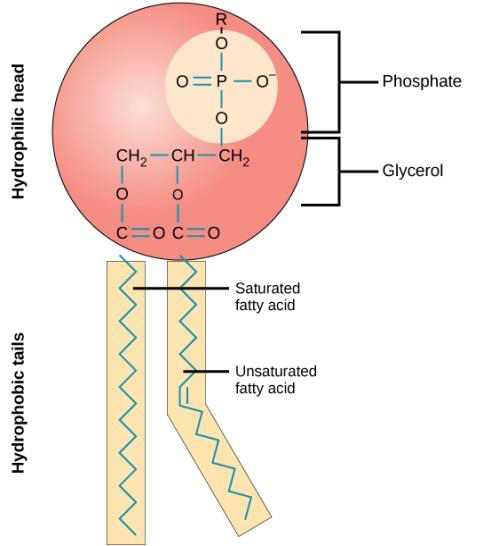
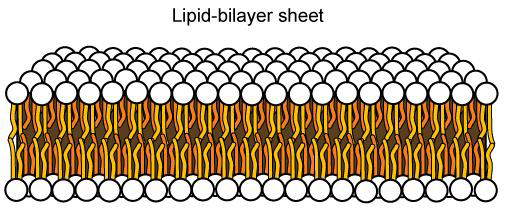
Figure \(\PageIndex\) Phospholipids form the basic structure of a cell membrane. Hydrophobic tails of phospholipids are facing the core of the membrane, avoiding contact with the inner and outer watery environment. Hydrophilic heads are facing the surface of the membrane in contact with intracellular fluid and extracellular fluid.
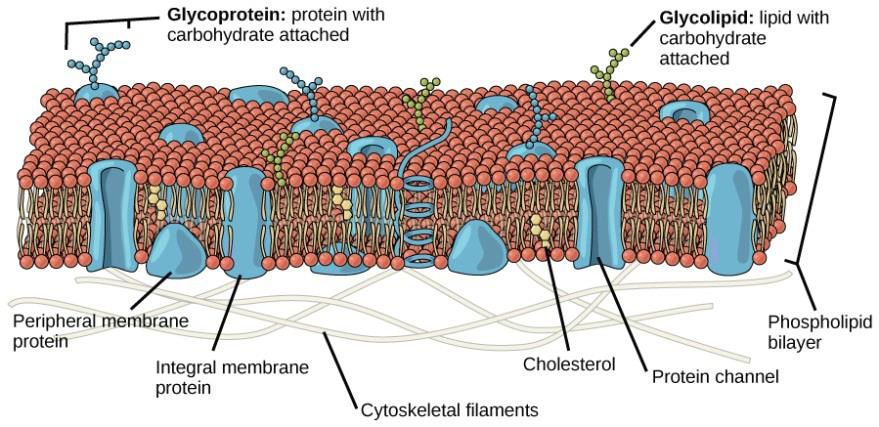
Figure \(\PageIndex\) Small area of the plasma membrane showing lipids (phospholipids and cholesterol), different proteins, glycolipids and glycoproteins.
Concepts, terms, and facts check
Study Questions Write your answer in a sentence form (do not answer using loose words)
1. What is the function of the cell membrane?
2. Which are the three types of biomolecules that form the cell membrane?
Almost all human cells contain a nucleus where DNA, the genetic material that ultimately controls all cell processes, is found. The nucleus is the largest cellular organelle, and the only one visible using a light microscope. Much like the cytoplasm of a cell is enclosed by a plasma membrane, the nucleus is surrounded by a nuclear envelope that separates the contents of the nucleus from the contents of the cytoplasm. Nuclear pores in the envelope are small holes that control which ions and molecules (for example, proteins and RNA) can move in and out the nucleus. In addition to DNA, the nucleus contains many nuclear proteins. Together DNA and these proteins are called chromatin. A region inside the nucleus called the nucleolus is related to the production of RNA molecules needed to transmit and express the information coded in DNA. See all these structures below in figure \(\PageIndex\).
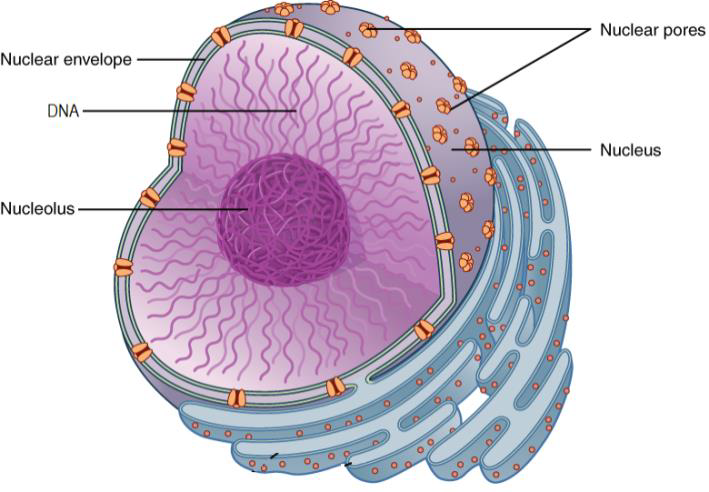
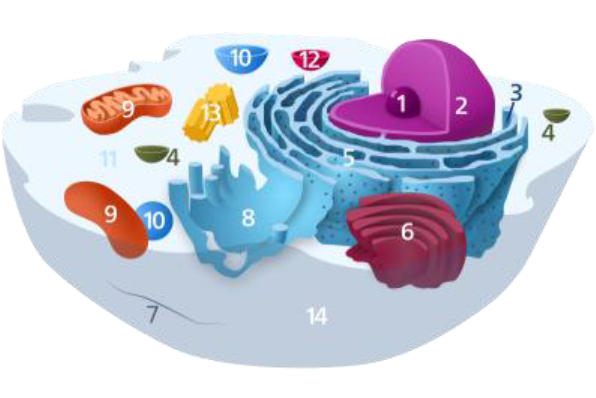
Figure \(\PageIndex\) Nucleus of a human cell. Find DNA, nuclear envelope, nucleolus, and nuclear pores. The figure also shows how the outer layer of the nuclear envelope continues as rough endoplasmic reticulum, which will be discussed in the next learning objective.
Concepts, terms, and facts check
Study Questions Write your answer in a sentence form (do not answer using loose words)
1. What is the nuclear envelope?
2. What is a nuclear pore?
3. What is the function of the nucleus?
An organelle is any structure inside a cell that carries out a metabolic function. The cytoplasm contains many different organelles, each with a specialized function. (The nucleus discussed above is the largest cellular organelle but is not considered part of the cytoplasm). Many organelles are cellular compartments separated from the cytosol by one or more membranes very similar in structure to the cell membrane, while others such as centrioles and free ribosomes do not have a membrane. See figure \(\PageIndex\) and table \(\PageIndex\) below to learn the structure and functions of different organelles such as mitochondria (which are specialized to produce cellular energy in the form of ATP) and ribosomes (which synthesize the proteins necessary for the cell to function). Membranes of the rough and smooth endoplasmic reticulum form a network of interconnected tubes inside of cells that are continuous with the nuclear envelope. These organelles are also connected to the Golgi apparatus and the plasma membrane by means of vesicles. Different cells contain different amounts of different organelles depending on their function. For example, muscle cells contain many mitochondria while cells in the pancreas that make digestive enzymes contain many ribosomes and secretory vesicles.
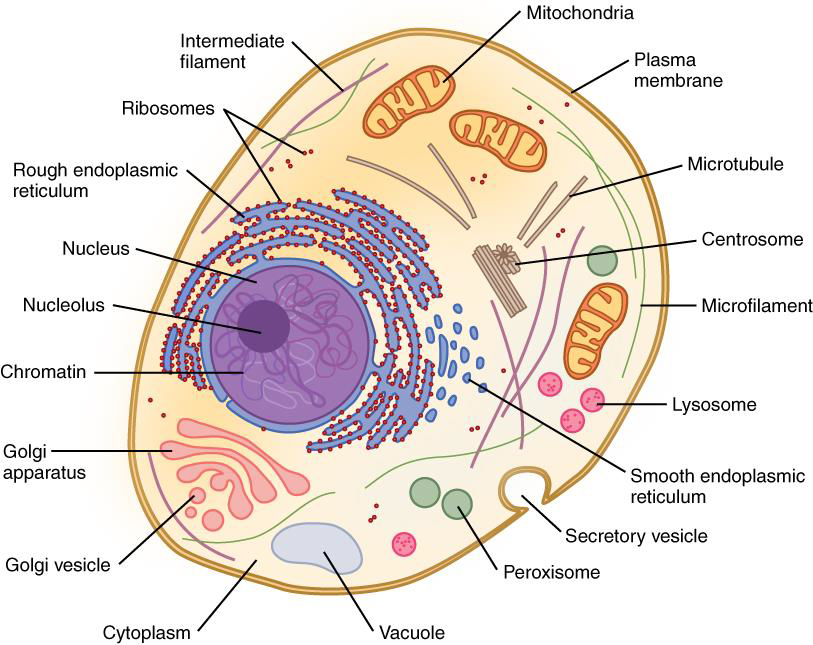
Figure \(\PageIndex\) Typical example of a cell containing the primary organelles and internal structures. Table \(\PageIndex\) below describes the functions of mitochondrion, rough and smooth endoplasmic reticulum, Golgi apparatus, secretory vesicles, peroxisomes, lysosomes, microtubules and microfilaments (fibers of the cytoskeleton)
Ribosomes
(shown here synthesizing a protein)
Found attached to RER and free in the cytosol
Fibers of the Cytoskeleton
(a) microtubule made of tubulin,
(b) microfilament made of actin, and
(c) intermediate fibers made of keratins
Centrioles
(found in an area in the cell called centrosome)
Concepts, terms, and facts check
Study Questions Write your answer in a sentence form (do not answer using loose words)
1. What is an organelle?
2. Which are the organelles listed in the module?
4.1: Cell Structure and Function is shared under a CC BY-NC-SA license and was authored, remixed, and/or curated by LibreTexts.